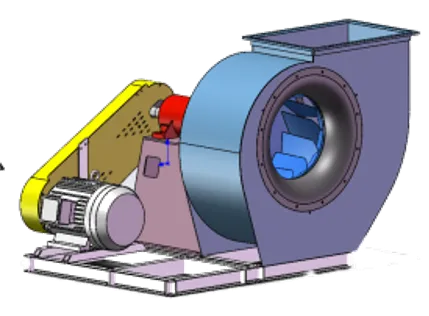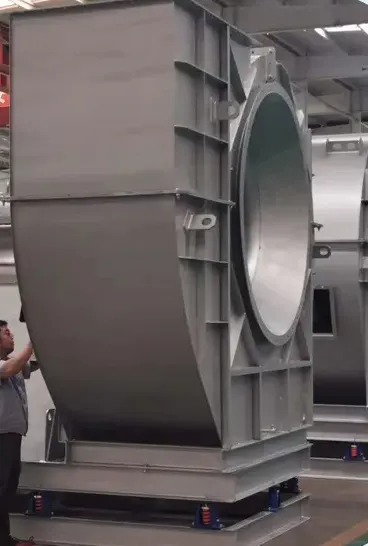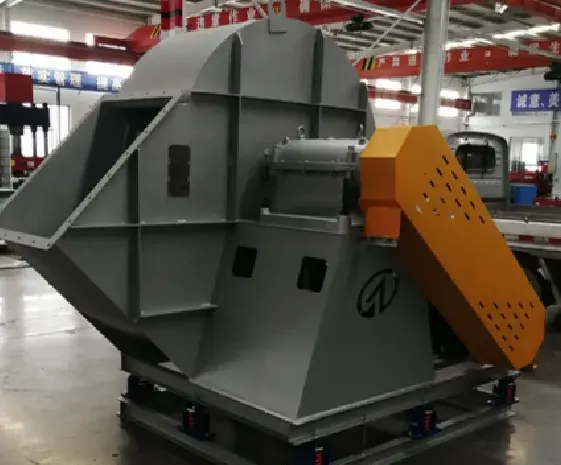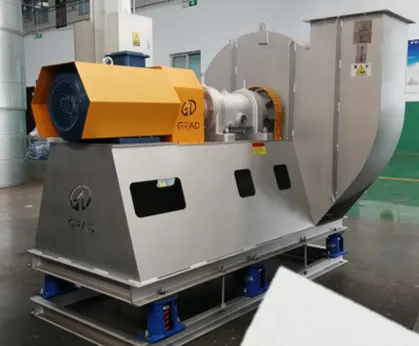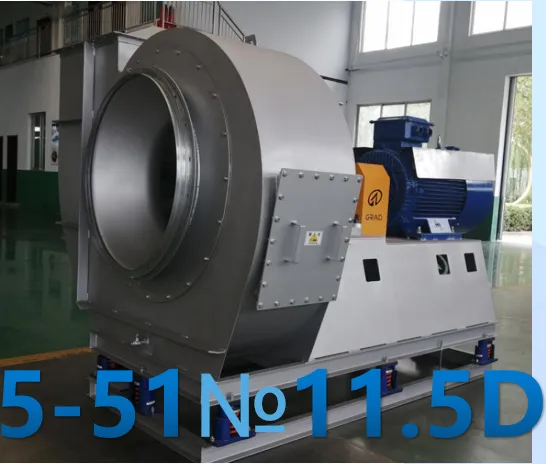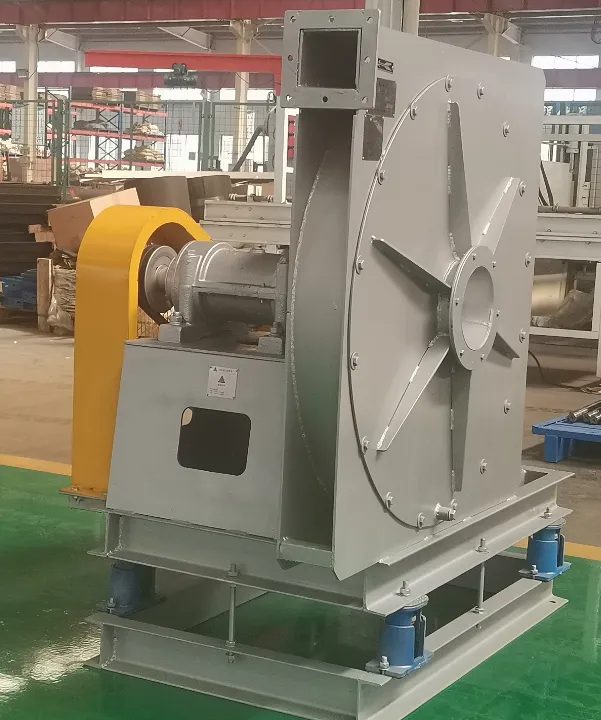SJG Diagonal Flow Fans
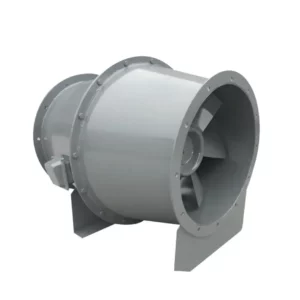
SJG Diagonal Flow Fans provide exceptional airflow for a wide range of industrial and commercial applications. Their cutting-edge design combines the strengths of both axial and centrifugal fans, making them ideal for environments that demand high airflow while maintaining low noise levels.
These fans represent a dependable and efficient choice for various air movement requirements. With their impressive efficiency and quiet operation, they are well-suited for multiple applications, contributing to enhanced comfort and productivity.
By following proper installation and maintenance guidelines, users can maximize the performance and longevity of SJG Diagonal Flow Fans. Choosing these fans means investing in a robust air management solution that meets the evolving needs of today’s industrial and commercial environments.
SJG Diagonal Flow Fans Parameter:
Get in Touch for Specific Dimensions
Key Characteristics of SJG Diagonal Flow Fans:
Exceptional Energy Efficiency
SJG Diagonal Flow Fans are meticulously designed to optimize airflow while minimizing energy usage. This impressive efficiency leads to substantial cost savings for businesses, enabling them to operate sustainably. By lowering energy expenditures, these fans not only enhance profitability but also support environmental initiatives, making them an ideal choice for organizations committed to sustainability.
Wide-Ranging Applications
These fans boast remarkable versatility, suitable for numerous environments. From HVAC systems and industrial processes to agricultural settings and commercial spaces, SJG Diagonal Flow Fans seamlessly adapt to varied applications. Their capability to meet diverse airflow requirements makes them an essential component across multiple sectors, ensuring consistent and effective performance.
Robust and Reliable
Built with premium materials, SJG Diagonal Flow Fans are engineered for longevity and reliability. Their sturdy construction offers excellent resistance to wear and tear, ensuring dependable operation during continuous use. This durability minimizes the need for frequent maintenance and replacements, allowing businesses to concentrate on their primary operations without interruptions.
Space-Efficient Design
The compact design of SJG Diagonal Flow Fans simplifies installation, even in tight spaces. This feature is particularly beneficial in environments where every square foot counts, allowing for efficient airflow management without extensive alterations to existing systems. Companies can leverage powerful airflow solutions without compromising valuable floor space.
Low Noise Levels
Designed for quiet operation, SJG Diagonal Flow Fans significantly improve workplace comfort. Their reduced noise levels help create a serene environment that enhances productivity by minimizing distractions. This focus on acoustic performance is crucial in settings that require high concentration, ensuring employees can work effectively without the disruption of excessive noise.
By selecting SJG Diagonal Flow Fans, businesses gain not only an efficient airflow solution but also improved operational efficiency and a more conducive working environment. Discover the advantages of exceptional energy efficiency, versatility, robustness, space-saving design, and quiet operation with these advanced fans, and transform your operational landscape.
Usage Method of SJG Diagonal Flow Fans:
Site Assessment
Start your installation process with a thorough site assessment to identify the optimal location for the fan. Analyze the installation area by considering existing ductwork, space constraints, and specific airflow requirements. This initial evaluation is crucial for ensuring efficient performance and effective air circulation. Take measurements and visualize how the fan will integrate into the existing system, allowing for a smoother installation process.
Installation
When you’re ready to install, carefully follow the manufacturer’s guidelines to secure a stable mount for the fan. Ensure that the fan is level during installation to prevent any operational issues arising from misalignment. Depending on your specific needs, you can choose to install the fan in-line with existing ductwork or as a standalone unit. Each option offers its advantages, so select the one that best suits your ventilation strategy.
Ductwork Connection
Integrating the fan with your existing ductwork is a critical step. Ensure all connections are airtight to prevent airflow leaks, which can significantly reduce the fan’s efficiency and overall performance. Proper sealing not only maximizes airflow but also contributes to energy savings, making your ventilation system more effective. Utilize high-quality sealing materials to guarantee long-lasting integrity at the joints.
Electrical Setup
Next, focus on the electrical setup. Connect the fan to the power supply while strictly adhering to all relevant electrical safety protocols. This step is essential for ensuring the safe and reliable operation of the fan. Double-check all connections for security and reliability; a well-secured electrical setup minimizes the risk of failures and enhances the longevity of the fan.
System Testing
Once the installation is complete, conduct thorough system testing to ensure that the fan operates at the desired capacity. Monitor airflow rates and verify that everything functions as expected. If necessary, make adjustments to optimize performance. This final testing phase is vital for confirming that your ventilation system meets your specific airflow requirements and operates efficiently.
SJG Diagonal Flow Fans Application:
SJG Diagonal Flow Fans offer versatile airflow solutions that cater to a variety of industries. Their efficient design and performance make them suitable for numerous applications. Here’s a look at some key areas where these fans shine:
1. Industrial Processes
- Exhaust Systems: Effectively remove hot air and fumes from manufacturing areas, enhancing safety and comfort.
- Process Cooling: Essential for cooling machinery and equipment, ensuring they operate at optimal temperatures.
2. HVAC Systems
- Cooling Towers: Improve heat exchange efficiency in HVAC setups.
- Ventilation: Enhance indoor air quality through adequate air circulation in commercial and residential systems.
3. Agricultural Environments
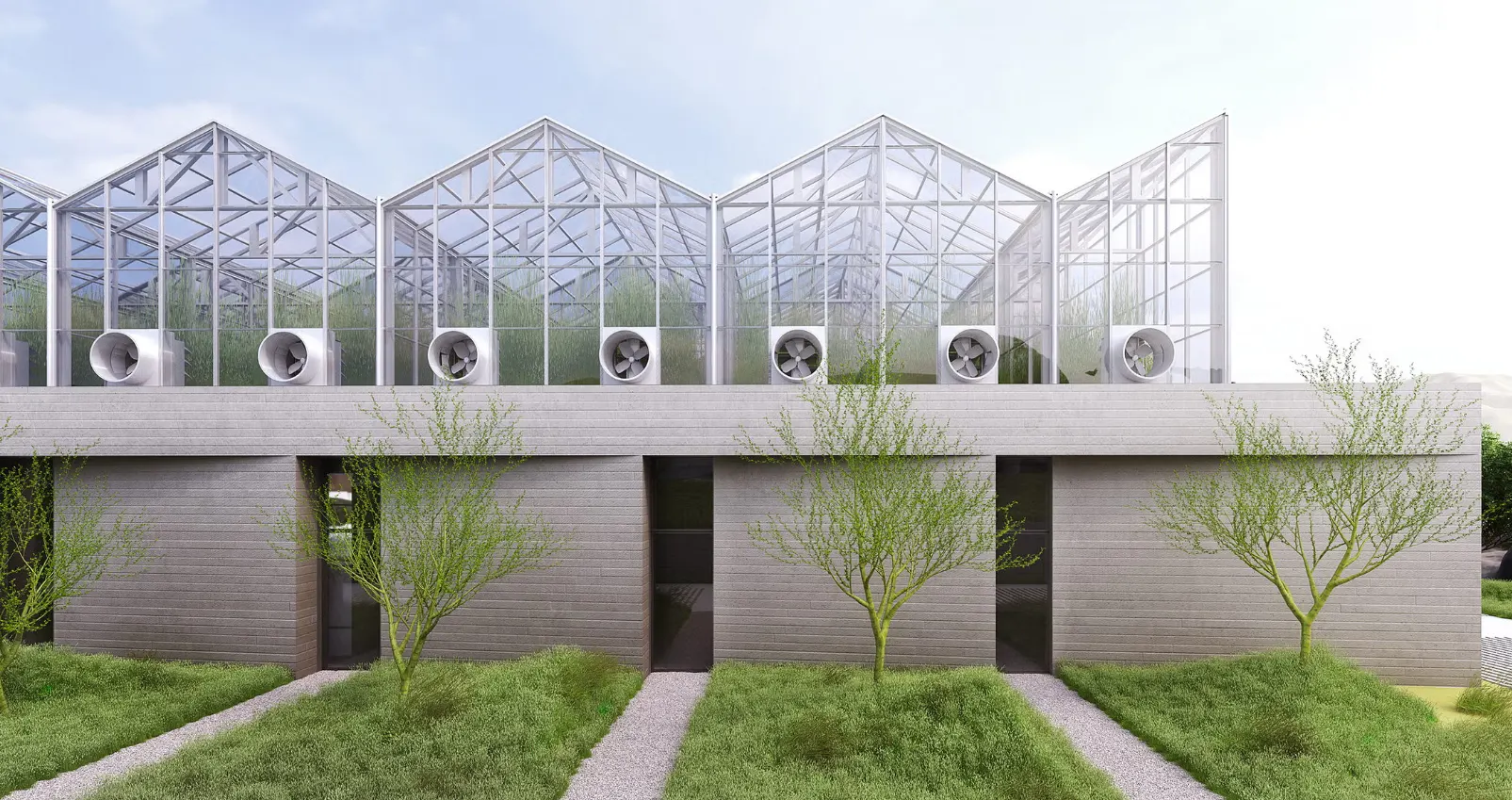
- Greenhouses: Promote optimal growing conditions by facilitating air circulation and temperature control.
- Livestock Facilities: Improve ventilation to create a healthy animal environment, regulating temperature and humidity.
4. Food Processing
- Airflow Management: Maintain hygiene and prevent contamination in processing and storage areas.
- Cooling: Help cool products and equipment, preserving quality and safety.
5. Chemical and Pharmaceutical Industries
- Fume Extraction: Efficiently exhaust hazardous fumes and vapors, ensuring compliance with safety regulations.
- Controlled Environments: Provide essential airflow in cleanrooms and laboratories, maintaining high air quality standards.
6. Data Centers
- Heat Management: Manage heat generated by servers and equipment, ensuring optimal operating conditions for IT infrastructure.
- Cooling Efficiency: Enhance cooling effectiveness, supporting reliable performance of critical systems.
7. Marine and Offshore Applications
- Ventilation: Provide essential air circulation in confined spaces on ships and offshore platforms, ensuring personnel safety and comfort.
- Durability: Built to withstand harsh marine environments, offering longevity and reliability.
8. Commercial Buildings
- Air Quality Improvement: Enhance airflow in offices, retail spaces, and public buildings, contributing to a comfortable environment.
- Energy Efficiency: Help reduce energy consumption in heating and cooling systems, supporting sustainability initiatives.
Fans Type:
Centrifugal fans can be categorized based on pressure levels into three main types: low pressure (P ≤ 1000 Pa), medium pressure (P = 1000–5000 Pa), and high pressure (P = 5000–30000 Pa).
Low-Pressure Fans
Typically represented by series such as 4-72, 4-73, 4-68, and 4-79, low-pressure fans feature blades that are primarily backward inclined, usually at an angle of about 45 degrees. These fans are known for their large airflow capacity, low noise levels, and stable operation, making them ideal for general ventilation applications.
Medium Pressure Fans
Medium-pressure fans, including series like 5-51, 6-30, 6-41, and 6-51, have a larger outlet angle than low-pressure fans, typically around 50 degrees. They also provide significant airflow while maintaining low noise levels and are less prone to overload. This makes them suitable for a variety of ventilation needs.
High-Pressure Fans
High-pressure fans, represented by 9-19, 9-26, 9-12, and 8-09, generally feature forward-tilted blades with angles less than 90 degrees. These fans are designed to supply forced air effectively and are utilized when higher pressure is required.
Direction of Rotation
When viewed from the motor side, fans can rotate in two directions: counterclockwise (left) or clockwise (right).
Angle Options
The fan blade angles are categorized as follows: 0 degrees, 45 degrees, 90 degrees, 135 degrees, 180 degrees, 225 degrees, and 270 degrees.
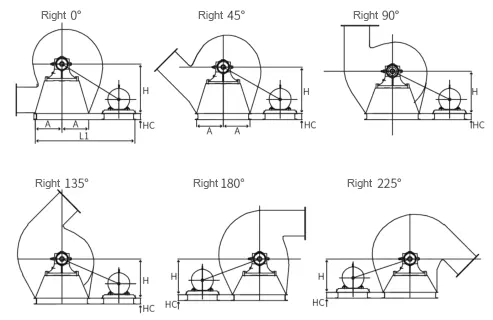
Type A Direct Transmission:
Type D Direct Transmission:
Type C Belt Transmission:
Type E Belt Transmission:
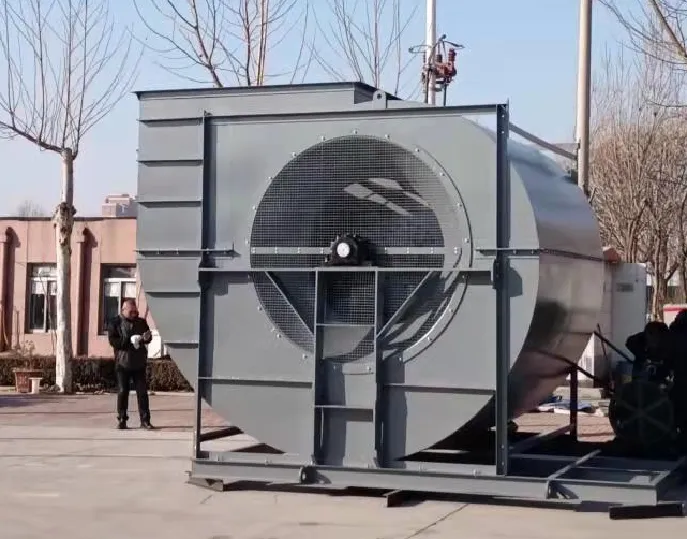
Type E Direct Transmission:
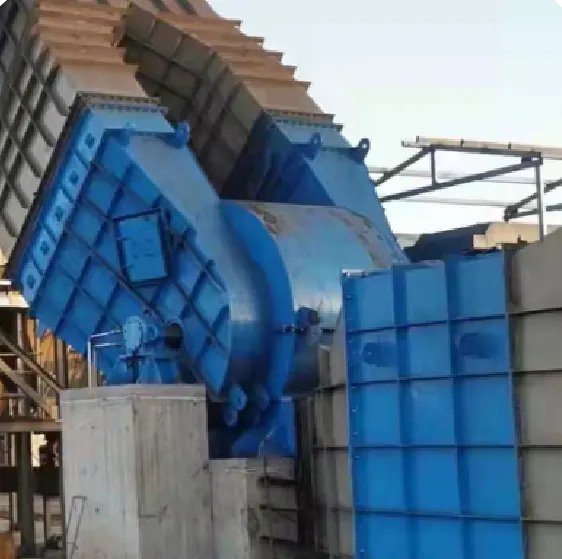
Low Pressure Fans:
Low-pressure fan series, including the 4-72, 4-73, and 4-79 models, are primarily designed for indoor ventilation in general factories and large buildings. These fans can function as both intake and exhaust systems and are also suitable for forced ventilation in applications such as boilers and forging furnaces.
- Smooth Operation: Ensures reliable performance with minimal vibration.
- Compact Design: Occupies a small footprint, making it easy to integrate into various spaces.
- Low Noise Levels: Operates quietly, contributing to a comfortable environment.
- High Efficiency: Delivers effective air movement while consuming less energy.
- Versatile Usage: Capable of handling air and other non-corrosive, harmless gases without affecting human health.
Low-pressure fans are widely used in:
- Garage Ventilation: For air supply and exhaust in parking facilities.
- Civil Defense Systems: Ensuring adequate air circulation in emergencies.
- Textile Industry: Used for exhaust systems to maintain air quality.
- Grain Storage: Assisting in the drying process within grain warehouses.
Medium Pressure Fans:
The primary models of medium-pressure fans include the 5-51, 6-51, 5-47/5-48, and 6-41 series. These fans deliver lower air volumes and pressures compared to low-pressure fans, yet they are known for their excellent aerodynamic performance, high efficiency, low noise levels, and smooth operation.
Applications
- Boiler Feed Fans: The G and Y6-51 models are specifically designed for use in thermal power plants, catering to steam generation capacities ranging from 2 to 670 tons per hour. These fans ensure that the air supply system of the boiler meets the performance parameters required for high-pressure head applications, such as fluidized bed furnaces.
- Dust Removal and Mine Ventilation: These fans are also effective in dust extraction and general ventilation systems.
Functionality
- Air Transport: These fans are primarily used for transporting air, while induced draft fans are designed to handle gases containing impurity particles.
- Dust Handling: They can operate effectively when the concentration of impurities is below 200 mg/m³ for over four years. However, if the dust levels are high, the blades should be treated with wear-resistant coatings to enhance their durability.
Temperature Specifications
- G Series Fans: Typically designed for normal temperature operations.
- Y Series Induced Draft Fans: Can withstand temperatures up to 250°C. If operating conditions exceed this temperature, it is advisable to switch to materials better suited for higher heat to ensure optimal performance and longevity.
In summary, medium-pressure fans are versatile and efficient, suitable for various applications, including boiler feed systems and ventilation, while offering adaptability to different operational conditions.
High Pressure Fans:
Fans Factory: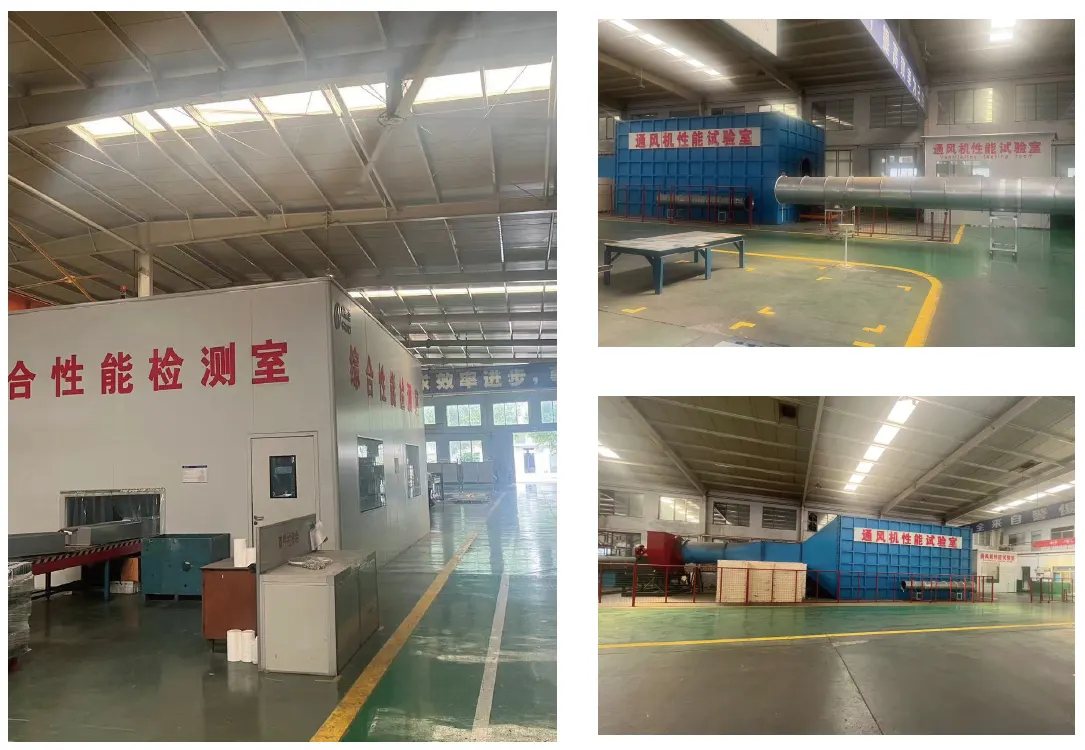
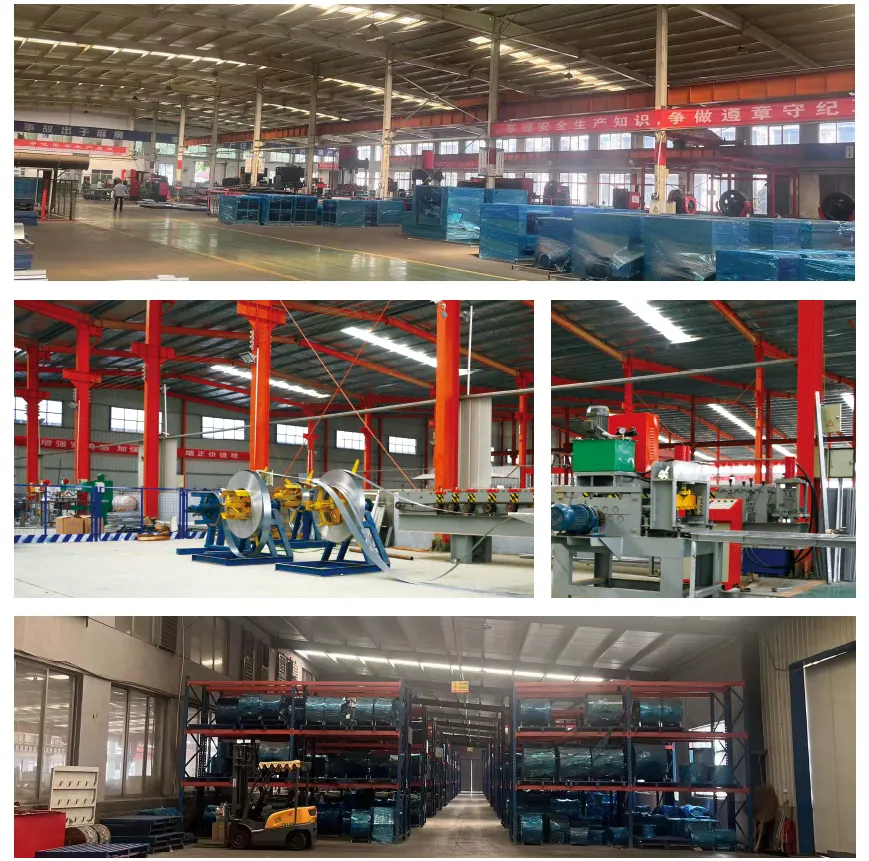
Our unwavering commitment to excellence encompasses a comprehensive 24/7 on-site service, ensuring that you have immediate access to top-tier maintenance support whenever you need it. We understand that operational efficiency is critical, which is why our team is always ready to assist you, regardless of the time or day.
Proactive Maintenance Approach
Detailed User Profiles: We take the time to develop thorough user profiles tailored to your specific systems and needs. This personalized approach allows us to understand the intricacies of your operations and tailor our support accordingly.
Regular Site Visits: Our team conducts routine site visits to monitor system performance and identify potential issues before they escalate. This proactive strategy ensures that we address any operational challenges swiftly, minimizing downtime and disruption to your workflow.
Comprehensive Support
Expert Technicians: Our highly trained technicians bring expertise and experience to every interaction, providing you with knowledgeable insights and effective solutions. You can trust that your systems are in capable hands.
Tailored Solutions: We prioritize your unique requirements, offering customized solutions that enhance your system’s performance and reliability. Our goal is to ensure that your operations run seamlessly.
With our dedicated support, you can enjoy peace of mind knowing that your success is our top priority. We are committed to fostering a collaborative partnership, where your needs drive our services. Our responsive support team is always just a call away, ready to assist with any challenges you may encounter.
Experience the difference that our comprehensive, proactive maintenance and exceptional support can make in your operations. Together, we will ensure your systems operate at their best, empowering your success every step of the way!










